Expressive Nature Photography
by Brenda Tharp–
Photography is pure joy. The ability to see something special and capture it in the camera is nothing short of amazing for me, even after all the years I’ve been a photographer.
From the tiniest detail of a flower to the grand expanse of the Milky Way stretching overhead at night, our world is an outstanding place, providing countless opportunities to experience beauty.
To be out photographing in nature is truly the best job one could have, at least according to the many who wish they were doing my job.

17-40mm lens at 40mm, f/7.1 for 1/200 sec. © Brenda Tharp.
The dolphin created a pressure wake above its body just before breaking the surface. The pure and calm waters of Johnstone Strait off the coast of Vancouver Island, British Columbia, allowed me to see down into the water to capture this special moment.

150-600mm lens at 552mm, f/13 for 1/1000 sec. © Brenda Tharp.
When I saw this mother bear lying in the meadow, at first I thought the photo would just be funny, with her legs splayed so she could place her belly on the cooling grasses. But when the little cub walked over, sat, and leaned against her, that was a special gesture. This photograph draws out the “ahhh” from just about everybody who sees it because of the emotion it expresses.
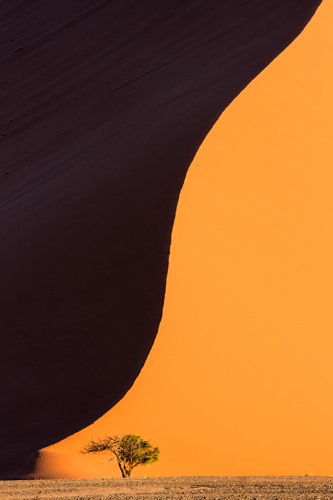
150-600mm lens at 309mm, f/16 for 1/80 sec. © Brenda Tharp.
The sweet light on this dune in the Sossusvlei within Namib-Naukluft National Park in Namibia was incredible. The light/shadow from sidelight highlighted a wonderful S curve, a sensual line that divided the space gently, while leading the eye to the tree. I was lucky; the next day was hazy, and the dune images were not as dynamic. Work the light when it happens!

150-600mm lens at 675mm (effective focal length*), f/11 for 1/640 sec. © Brenda Tharp.
Nothing beats a great reflection, and this zebra drinking at the waterhole in Namibia was the perfect way to start off the morning. We enter the frame on the left, and the eye is taken from the left side of the zebra to the right, and down into the water and back left, completing a circular motion. This continues the more we look at it. With the zebra and its reflection being the focal point of the picture, and since there was nothing of interest on either side of the animals, it just made sense to consider a square crop to emphasize the symmetry of the scene. The stripes add visual tension, because of the pattern of lines creating a feeling of movement, making the picture eye-catching.

70-200mm lens at 300mm (effective focal length*), f/10 fo 1/1000 sec. © Brenda Tharp.
Filling the frame with your subject creates more impact in the picture. This cheetah was basking in the hot sun of morning in Namibia, and I loved the expression on its face. The sun was so strong and low that it was actually being blinded by light, no doubt, but I took advantage of that squint to capture a cute moment, almost like it was saying “Ah, that sun feel so good.” Filling the frame with the cheetah was achieved with a crop afterward, as the lens wasn’t long enough to do it in the field safely. Are they ever long enough for wildlife?
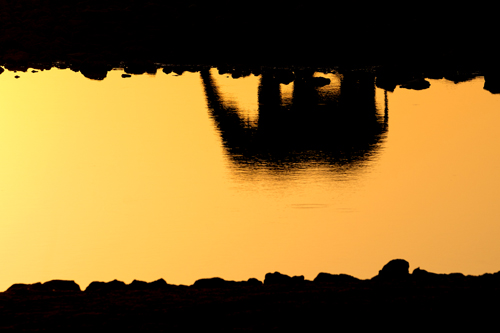
70-200mm lens at 300mm (effective focal length*), f/9 for 1/400 sec. © Brenda Tharp.
This interpretive view of an elephant walking by a watering hole in Africa at sunset was a fun way to capture a story without showing anything of the real elephant. By excluding the elephant and the resultant clutter around it, I was able to create more significance to the silhouetted shape. I waited for the shape to be identifiable before pressing the shutter.

70-200mm lens at 85mm, f/5.6 for 1/00 sec. © Brenda Tharp.
In the woods in Cuyahoga Valley National Park, Ohio, I spotted these three narcissus that, due to wind, had gotten stuck together, and I loved how they created an implied line from the top to the bottom flower. I worked to get as parallel as possible to them, and chose an aperture that would render them sharp but keep the busy background under control.
I don’t typically care for white skies in my pictures, but in this situation, the whiteness brought out the structure of the tree and the nests really well.

70-200mm lens at 155mm, f/8 for 1/500 sec. © Brenda Tharp.
A solid blue sky or one with a lot of clouds would have distracted a bit, whereas the black-and-white quality of this image keeps the viewer focused on the action and the story. I waited and got lucky when this heron flew in and “braked” for landing, filling that sky space perfectly to tell the story that this was an active rookery.
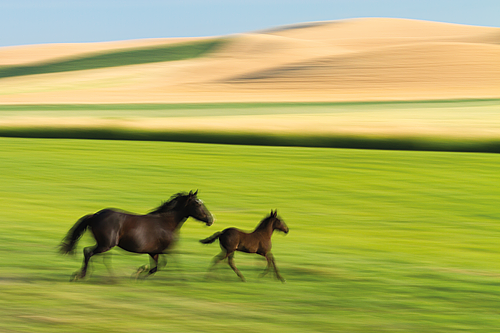
70-200mm lens at 89mm, f/16 for 1/6 sec. © Brenda Tharp.
This mother and her young colt were feeling the energy in the springtime air. As they burst into a run across the field, I quickly changed my settings to pan to capture the motion of their movement. I had only one chance to get it right and I was able to capture the energy and joy that I felt the horses were expressing in their run.
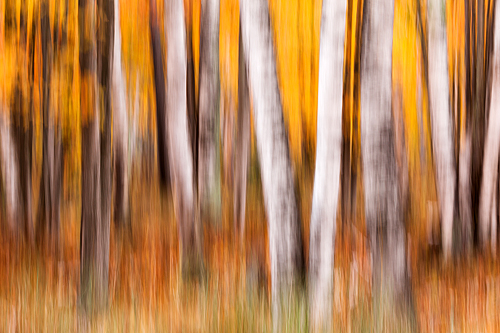
70-200mm lens at 100mm, f/16 for 1/6 sec. © Brenda Tharp.
The brilliant reds of maple trees behind the stand of birches in Minnesota were stunning. The contrast was so great in full sunlight that I had to wait for the sun to go behind a cloud to keep the whites of the trunks from being too bright. I tilted my camera with a slight wiggle to make the trees move expressively in the upward blur.
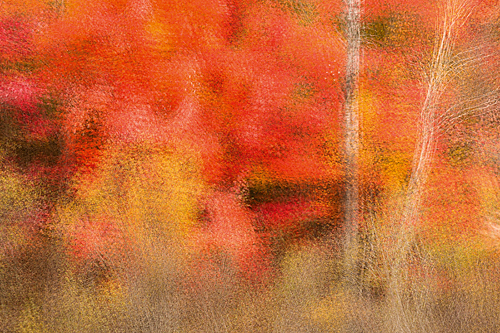
24-105mm lens at 105mm, f/9 for 1/80 sec. 8 exposures, individually, then combined in the computer. © Brenda Tharp.
I knew from experience this forest scene would be great for a multiple exposure, because it had a lot of details that could overlap, as well as colors. I never truly know the outcome until I try it, though! My DSLR allows me to save the originals and also combine them in the camera for a JPEG that tells me how I did; if successful, I move on to another scene. 24-105mm lens at 105mm, f/9 for 1/80 sec. 8 exposures, individually, then combined in the computer. © Brenda Tharp.
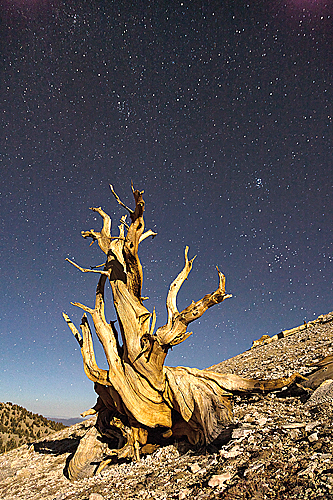
24mm lens, f/4 for 31 sec. ISO 400. © Brenda Tharp.
This was my first attempt with a digital camera to capture the stars as points of light, using a tree for my visual anchor. While camping one night in the White Mountains of California, the stars felt so close overhead, and I set out to photograph them with a bristlecone tree in the composition. Although I was knowledgeable about the technique, I hadn’t considered that I had a quarter moon in the sky! This reduced the number of stars that were visible, but it was the right amount to illuminate the tree and still capture some stars. Because my exposure was a little longer than it should have been for the focal length, there is slight movement in the stars when viewed large, but the overall effect still holds magic for me.
To go out and be in nature is reward enough, but it can often reward you all the more with great light and great moments. That’s the proverbial carrot that keeps me pursuing my photography.
When the weather, light, composition, and moment all come together into a great photograph, I realize how truly lucky I am to be there, and to be a photographer.
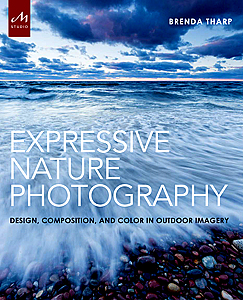
This article is an excerpt from Expressive Nature Photography: Design, Composition, and Color in Outdoor Imagery by Brenda Tharp, published by The Monacelli Press
It is available from Amazon, Barnes and Noble and other booksellers.
Ms. Tharp has been a professional photographer for over 33 years and is also an inspirational speaker, writer, workshop instructor, and tour leader.
Her award-winning images have appeared in national magazines and books, calendars, greeting cards, and posters and are used for interior-decor. Her fine art images are in private collections across the United States. She is a user of Red River Papers for greetings cards and promotes their use in her workshops.
Visit her website to view more of her work.
RESOURCES
*For an explanation of effective focal length click here.
To subscribe to Red River Paper’s newsletter, click here.
Original Publication Date: April 15, 2018
Article Last updated: April 15, 2018
Comments are closed.
Categories
About Photographers
Announcements
Back to Basics
Books and Videos
Cards and Calendars
Commentary
Contests
Displaying Images
Editing for Print
Events
Favorite Photo Locations
Featured Software
Free Stuff
Handy Hardware
How-To-Do-It
Imaging
Inks and Papers
Marketing Images
Monitors
Odds and Ends
Photo Gear and Services
Photo History
Photography
Printer Reviews
Printing
Printing Project Ideas
Red River Paper
Red River Paper Pro
RRP Newsletters
RRP Products
Scanners and Scanning
Success on Paper
Techniques
Techniques
Tips and Tricks
Webinars
Words from the Web
Workshops and Exhibits
all
Archives
March, 2024
February, 2024
January, 2024
December, 2023
November, 2023
October, 2023
September, 2023
August, 2023
May, 2023
more archive dates
archive article list







